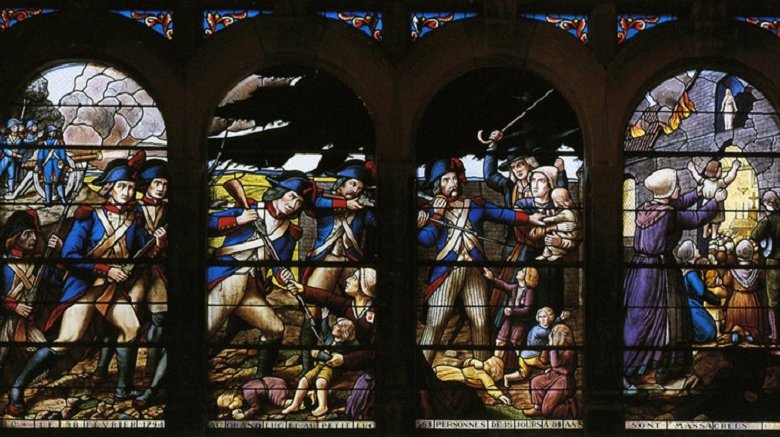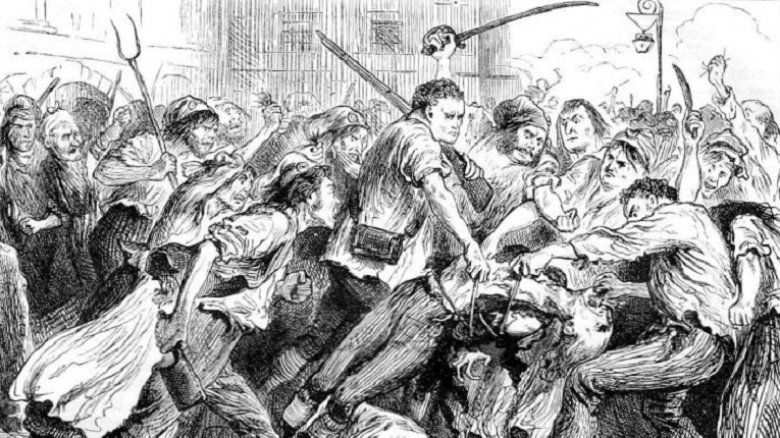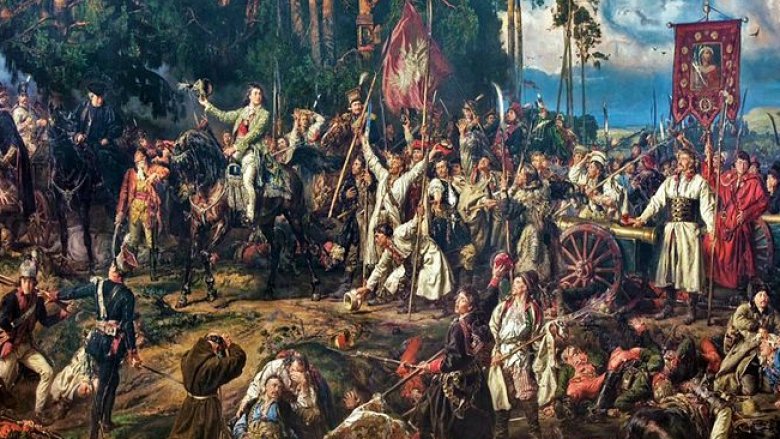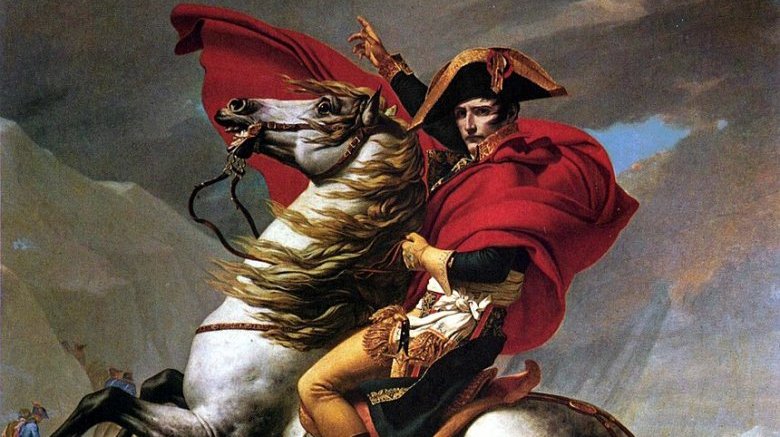The French Revolution Was Really Messed Up
The French Revolution is one of those historical events that everyone can agree was both super important, and super messed up, but very few regular folk actually know all that much about. The layperson's mental map of the political convulsions that gripped France at the end of the 18th century goes something like: "Fall of the Bastille, execution of the king, guillotine ... umm, Napoleon?" Of all those things, the one that has really stuck in the cultural memory is the freaky part where everyone went crazy and started chopping off each other's heads: The Reign of Terror.
But gory as it was, the Terror was really only one messed up aspect of the gigantic pile of Eton mess known as the French Revolution. While about 17,000 people got guillotined in the ten months of the Terror, all this bloodshed was just a drop in the ocean compared to the other crazy stuff that was going on at the same time. Forget baskets full of heads and executions on the streets of Paris. The seriously messed up stuff was happening elsewhere.
The storming of the Bastille was super gory
Even 230 years on, Bastille Day is still celebrated in France each July 14. The traditional beginning of the French Revolution, it commemorates when the oppressed masses of Paris spontaneously rose up in 1789 and tore down that hated symbol of royal tyranny the Bastille, freeing those imprisoned inside. Well, that's the Spark Notes version. In reality, the Bastille was nearly empty, and the mob who overwhelmed its defenses lynched the guy running it.
The whole thing was a major embarrassment. The mob were less interested in freeing prisoners than in getting their hands on the Bastille's weapons cache, which may explain why the guards shot 80 of the attackers dead. When the guy running the Bastille, Bernard-Rene Jourdan de Launay, surrendered, the mob didn't play nice.
De Launay was dragged through Paris by an armed gang and dumped before a mob outside the Hotel de Ville, who loudly debated the nastiest way to kill him. As the Encyclopedia Britannica describes it, de Launay responded by screaming "Enough! Let me die!" and kicking a man right in the babymakers. The crowd immediately fell on him, stabbed him to death, and sawed his head off. A butcher's apprentice then chopped up the rest of his body, handing out bits of de Launay to the crowd to wave in grisly triumph. They then lynched two more Bastille guards, because of course they did.
The infernal columns earn their nickname
When the French Revolution hit, the Vendee region in Western France was seriously unimpressed. As a poor, pious region it was a total nonstarter for the revolution's anti-clerical, middle-class bent. When the revolutionary government in Paris introduced forced conscription in February 1793, it was the last straw. The region exploded into rebellion (via Britannica). With the regular Revolutionary Army incapable of quashing the uprising, Paris turned to General Louis Marie Turreau, a man with a big idea, at least in terms of body count. Turreau wanted to conduct genocide.
As Mike Duncan explains in his Revolutions podcast, Turreau created something known as the Infernal Columns. Bands of armed men, they were given explicit orders to march into the Vendee and move from village to village, killing everyone in their path. Men, women, and children were mass executed, their livestock slaughtered, and their homes burned to the ground. The idea was that massacring civilians would shock the rebels into abandoning their fight, but it only made them fight even harder. So Turreau's columns of fiery death kept right on marching and killing until there was almost no one left to kill.
The Infernal Columns alone killed an estimated 20,000 to 40,000 civilians during the War in the Vendee, while the broader conflict killed up to 170,000 (via The Telegraph). The Reign of Terror, by contrast, killed 17,000. As recently as 2008, the Vendee was still asking Paris to recognize the Infernal Columns as genocide.
The Nantes baptisms
Here's a toughie. You're a French Revolutionary general placed in charge of pacifying a rebellious city where most of the population could be classed as counterrevolutionary. How do you make peace without simply killing everyone in sight? If you're Revolutionary Tribunal member Jean-Baptiste Carrier, there's no problem at all: you mass drown everyone and declare mission complete!
As the guy in charge of dispensing revolutionary justice in Nantes from November 1793 to February 1794, Carrier was nothing if not efficient. While his colleagues let the guillotine do all the work, Carrier was inventing new ways to kill more people with more speed. On November 16, he had a barge built that could be sunk in the Loire river at his command. That evening, Carrier used his new toy to simultaneously drown 90 priests. The results delighted him so much he named the process "Nantes baptisms."
In no time at all, Carrier's baptisms had moved on from priests to the entire population of Nantes. As Revolutions podcast describes, he took an almost sadistic pleasure in his work. Hundreds of men, women, and children would be drowned while Carrier ate fine foods on the bank. Men and women would be stripped naked, tied together, and hurled into the Loire in "Republican marriages." All told, Carrier managed to drown anywhere between 2,000 and 9,000 civilians in just three months.
This was too gory even for the revolutionaries. In December 1794, Carrier was convicted of mass murder and guillotined (via Britannica).
Robespierre's extremely bloody downfall
Maximilien Robespierre is the guy who made the Terror so damn terrifying. The major power on the Committee of Public Safety, he was the engine driving the cascade of tumbling heads that flooded Paris in 1793-94. But while Robespierre's life was shocking, his downfall and death were even worse. On 27 July 1794 (also known as 9 Thermidor, Year II), the moderate National Convention turned on the Committee and condemned its far left members to death (via Britannica). In the chaos, Robespierre and his closest friends fled for the shelter of the Hotel de Ville.
As soldiers closed in, Robespierre attempted to commit suicide using a pistol. As Revolutions podcast describes, he succeeded only in blowing half his lower jaw off, plunging his friends into a panic. In the confusion, wheelchair bound Georges Couthon fell from his chair down a flight of stairs, smashing his head open. Francois Hanriot attempted to escape out the hotel windows, but slipped and fell three stories into an open sewer. The book Revolution! claims he was only found hours later, paralyzed, covered in excrement, and with one eye dangling out its socket.
The very next day, the National Convention had all the survivors of the Hotel de Ville guillotined. Robespierre's jaw had been bandaged up, and he apparently tried to go out with some dignity. However, the executioner ripped off his bandage at the last moment. Robespierre's scream was blood chilling, and only ended when Madame Guillotine finally claimed his life.
The white terror was almost as nasty as the actual terror
In 1794, Robespierre and the Committee of Public Safety were guillotined in the Thermidorian Reaction. Almost immediately, all the revolutionary politicians in the National Convention who'd been cowed by the far left swung wildly to the right. The jails were emptied of political prisoners. Executions were halted. Survivors of the Reign of Terror were allowed to come crawling out of the shadows. No longer fearing for their lives, this should have been an excellent time for France's persecuted to give a collective sigh of relief. If they did, though, it was lost beneath the sound of them picking up pitchforks and giving a collective cry of vengeance.
As Britannica details, 9 Thermidor set off a chain reaction of anti-terrorist actions that quickly degenerated into mob rule. As the National Convention looked the other way, formerly persecuted moderates took up arms and started attacking their Robespierre-supporting neighbors. In Paris, this "white terror" (named after the family color of the Bourbon royals) involved gangs of middle-class youths badly beating any Jacobins they came across. Out in the Departments, though, it became a free-for-all of lynchings, counter-lynchings, and massacres.
In towns, jails were broken into and all the inmates murdered. In villages, peasants settled old scores by telling passing lynch mobs that their hated neighbors had totally been Robespierre's buddies. Overall, the White Terror of Thermidor would claim 2,000 lives, far less than the actual terror, but still 1,999 more than was really necessary. (The 1 is Robespierre.)
Reprisals against Lyon went totally overboard
1793 was a really, really bad year for the revolutionary government. The Vendee erupted in armed rebellion, and a ton of cities with historical beef against Paris joined the fray. Known as the Federalist Revolts, these city uprisings were all put down within months, but they still led to bloody reprisals. One of the bloodiest of all took place in Lyon.
At the time, Lyon was France's second largest city, so its revolt in June '93 was a major deal. When the revolt was crushed in December, Paris dispatched Committee of Public Safety member Jean-Marie Collot d'Herbois to make an example. As Revolutions podcast notes, Collot had previously worked as a theater director in Lyon, where he'd received absolutely terrible reviews. This may go some way explaining what happened next.
As judge, jury, and executioner for Lyon, Collot presided over a bloodbath that could stand alongside anything ISIS ever did. Annoyed by the glacial pace of guillotine executions, he instigated events where prisoners would be lined up in rows outside town and blasted with cannonfire. Sources from just after the revolutionary period state one of Collot's firing squads claimed over 900 lives on a single day. Exaggeration or not, it's thought that at least 2,000 Lyon citizens were killed in Collot's terror — although justice would eventually be served. In 1795, Collot was proscribed as a radical by the Directory and exiled to French Guiana. Britannica claims he died of yellow fever not long after landing.
The lonely death of Louis XVII
After Louis XVI got his head chopped off, France's revolutionaries found themselves with a pressing problem. Although the hated Louis was dead, his infant son — and potential Louis XVII — Louis-Charles was still alive. He was also only 8 years old, an age at which even the bloodthirsty mobs of Paris might riot if he was guillotined. So the Jacobins came up with a solution straight out of a Disney movie. They handed Louis-Charles over to a poor cobbler named Antoine Simon and instructed him to raise the child as a commoner. But rather than learning some catchy tunes and lessons about life, the boy found himself instead learning how crappy adults can be.
Biography has the details. While stories that Simon abused the boy seem to have been royalist propaganda, he certainly forced him to do awful things. At the trial of Louis-Charles' mother, Marie Antoinette, the boy was made to testify that the queen had sexually assaulted him as a child, a patently false accusation.
Bad as that was, at least Simon kept Louis-Charles alive. When the cobbler was forced to go away in January 1794, the boy was locked up in Paris' Temple prison and left to rot. Over the next year, the uncaring guards basically neglected him to death. Underfed, lonely, and utterly miserable, Louis XVII finally died of tuberculosis in summer 1795, aged 10. It took until 2004 for his remains to be identified and buried near his parents.
Parisian mobs make lynching the national sport
One of the key drivers of the whole revolution was mob violence in Paris. It was an angry mob that stormed the Bastille, an angry mob that forced the king to leave Versailles, an angry mob that drove the Insurrection of August 10 ... basically, if it happened during the French Revolution, it probably involved an angry mob. Unfortunately, that meant a whole lotta people not indulging in mob violence wound up getting lynched.
The earliest victims came in mid-1789. Just eight days after the fall of the Bastille, in which General de Launay had been killed by a mob, a completely different mob came after the Royal Governor of Paris and his father in law, Controller General Foulon. Captured outside the city, the two were accused of causing a recent famine, beaten to death, strung up, and decapitated. Foulon's death was particularly nasty. It's said he was dragged through the streets alive, forced to drink vinegar, and then made to eat straw before being killed. The incident was so famous Charles Dickens included it in A Tale of Two Cities.
Foulon may have been one of the first, but he wasn't the last. Fear of lynching was so great that history podcaster Mike Duncan has argued it drove the National Convention's delegates to adopt crazy radical legislation. As late as 1795, the unwashed masses were able to break into the seat of revolutionary government in Paris and string up and decapitate a deputy.
Poland's copycat revolution kills way more than France's
So, you may be wondering how you get from the French Revolution to the 1794 Polish Uprising. Well, it's complicated, but the super-basic version is that Poland was partially under occupation by Austria, Prussia, and Russia, two of whom just happened to be distracted fighting revolutionary France. Polish leader Tadeusz Kosciuszko recognized it might be a good time to get a rebellion going, and, as Britannica describes, went to Paris in 1793 to ask for money, arms, and advice. France's revolutionary leaders helped a lot with the advice, and kinda implied they'd help even more militarily. Kosciuszko went home ready to get his revolution on.
In 1794, he did just that. In a system clearly modeled on France's Jacobin clubs, he installed revolutionary societies across the nation then triggered an uprising against the invaders. Mobs in Warsaw lynched Russian families, Krakow exploded in rebellion, and bands of peasants formed into armies to kick the invaders out. Game on!
Sadly for Poland, French help didn't really materialize, and Russian retaliation really did. Although Kosciuszko came close to pulling off his copycat revolution, his armies were crushed before the year was out. The Dictionary of War details what happened next. Russia instigated its own Reign of Terror around rebellious Warsaw. By historian Mike Duncan's count, more died in a single day of Russian reprisals than died in the entire French Reign of Terror. In the aftermath, Austria, Prussia, and Russia partitioned Poland, wiping the nation from the map until 1918.
Executions for losing battles
Quick: What's the difference between career army officers during the French Revolution and counter-revolutionaries condemned to the guillotine? Answer: Counter-revolutionaries actually stood a pretty good chance of surviving.
Of the 300,000 people arrested during the Reign of Terror, Britannica notes only 17,000 were guillotined. Revolutionary army generals, on the other hand, suffered a casualty rate that would put the Black Death to shame. After the Girondist faction provoked a war with Prussia and Austria in 1792, Representatives on Mission were dispatched to make sure no elitist officers deliberately lost their battles. In practice, this meant any general who didn't win even in impossible circumstances wound up getting guillotined.
The first to discover this was Theobald Dillon, who the Dictionary of National Biography notes was lynched by his own troops after losing a battle in 1792. Not long after, the fun really began. Louis Antoine de Saint-Just, known to history as the "Angel of Death," had General Isambert shot in front of his men, according to one history of Europe, for "showing insufficient determination." Comte de Custine meanwhile was guillotined for losing a battle, while General Jean Nicolas Houchard actually won his battle against the Austrians but was guillotined anyway for failing to press his tactical advantage. Arthur Dillon, a relative of Theobald, also lost his head for writing to a German prince. It wasn't until Lazare Hoche and Napoleon Bonaparte began routinely beating impossible odds that this insane turnover of the officer corps finally stopped.
That time Napoleon abandoned his army to die in Egypt
In the aftermath of 9 Thermidor, a previously little-known general began to rise to prominence. Napoleon Bonaparte was soon so popular that the ruling Directory decided now might be a good time to get him away from the levers of power. In 1798, they dispatched Napoleon at the head of an army to conquer Egypt.
Today, the expedition is known for its scientific advances, like discovering the Rosetta Stone (which enabled us to read hieroglyphics). The bit that always gets left out is the part where Napoleon abandoned his army to die in the desert (via ThoughtCo).
Napoleon's plan had been to keep a French fleet on standby at Alexandria in case he needed to send for reinforcements. Unfortunately, that plan hadn't counted on the British navy blowing the entire French fleet to smithereens. Trapped in Egypt, Napoleon gamely soldiered on through an invasion of Syria, but when the Ottoman Empire declared war he must've known the writing was on the wall. In March 1799, the little corporal made a rousing speech to his troops before retiring to bed. The next morning the army woke up to find their leader gone.
Napoleon had taken the last boat back to France in the night and left his men to their horrible fates. The remaining soldiers were devastated by plague, murdered by locals, and butchered by rampaging Ottoman forces. In 1802 they finally surrendered to the British. By then, Napoleon was already well on his way to becoming emperor.











